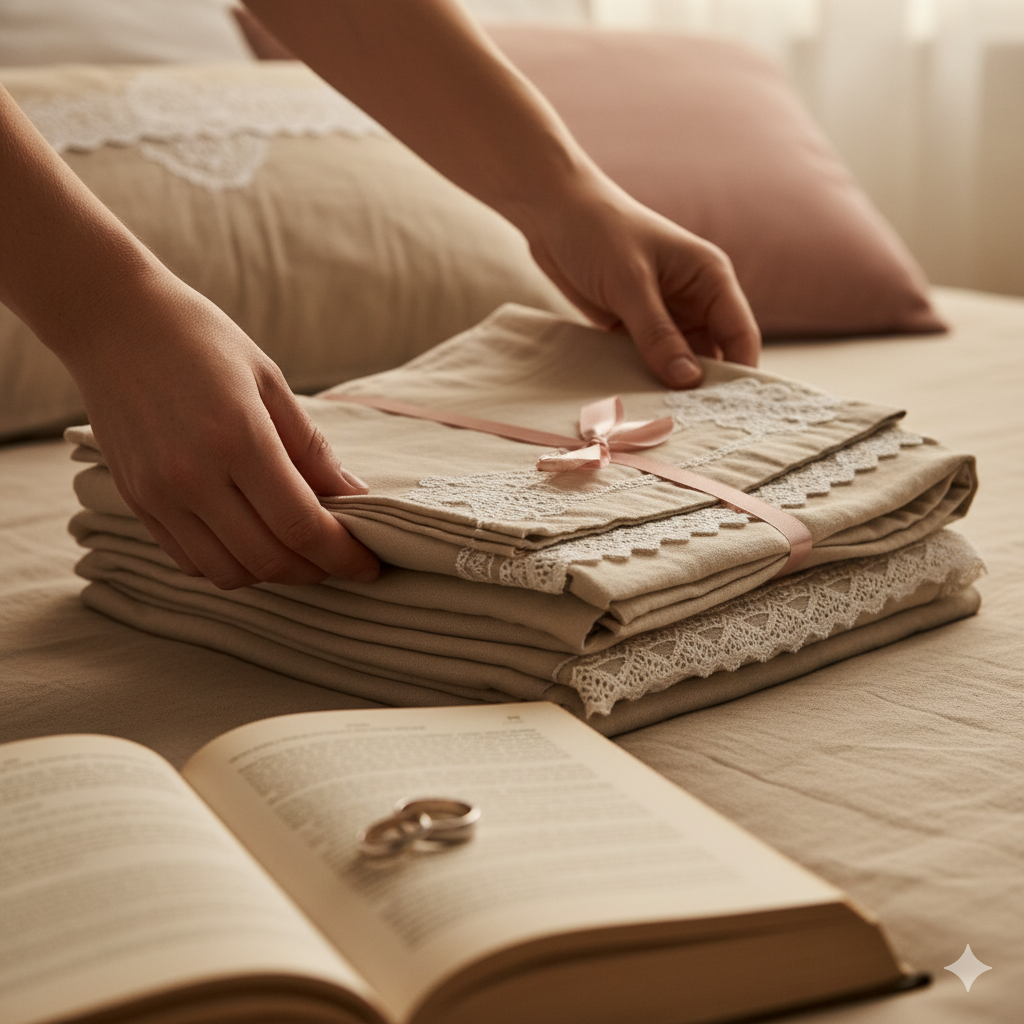Wedding bedding ceremonies: history, meanings & modern echoes
Wedding bedding ceremonies blended celebration, community, and symbolic consummation. Though no longer practiced, wedding bedding ceremonies still echo through modern customs like threshold carries, honeymoon suites, and first dances.
Key Takeaways
- Wedding bedding ceremonies publicly affirmed marriage legitimacy and community approval.
- Over time, rituals shifted from public observance to private symbolism.
- Modern traditions—first dances, threshold carries, honeymoon suites—echo that same passage from public to private.
Medieval Europe: When Weddings Were a Community Affair
Answer first: In medieval Europe, wedding bedding ceremonies acted as communal endorsements that legitimized the union and safeguarded lineage.
Among the nobility, marriages often served political or economic aims. The wedding bedding ceremony made alliances visible: after feasting, guests paraded the couple to bed with songs or playful verses, a public seal on a private bond. Clergy or elders sometimes blessed the couple, underscoring unity as much as intimacy.
Traces of this communal spirit live on in toasts and first dances. For a deeper look at room energy and tradition in private spaces, see our guide to Feng Shui principles for bedroom layout.
Behind Closed Doors: Public Approval Meets Private Intimacy
Answer first: Once doors closed, the performance ended and the personal relationship began—community approval gave way to privacy.
Spiritual Blessings and Fertility Symbols
Answer first: In Catholic regions, priests blessed beds and spaces, framing the wedding night as sacred, not merely social.
Rooms were decked with rosemary, lavender, and floral emblems meant to invite fertility and happiness. The bedroom became a sanctified setting, where physical union carried spiritual significance.
For scent-based rituals that promote calm sleep today, explore 7 essential oils for sleep and how aromatherapy enhances rest.

Behind Closed Doors: Sacred Spaces
Answer first: Blessings and symbols turned ordinary rooms into sacred havens for the couple.
That same impulse inspires today’s couples to curate restful spaces with intentional materials; see our temperature-regulating bedding guide.
Royalty and Legal Implications
Answer first: For royals and aristocrats, wedding bedding ceremonies served legal and dynastic ends—witnesses affirmed legitimacy for succession.
Tokens or documentation sometimes stood as proof of consummation—intrusive by modern standards, but once essential for inheritance continuity. Today’s parallel is quieter: prenuptial agreements and legal frameworks protect property and heirs without public ritual.
To compare how bed style intersects with status and tradition, browse canopy bed styles, from classic to modern.

Behind Closed Doors: Legal Seals
Answer first: Formal witnessing once secured dynastic continuity; today, contracts quietly play that role.
Renaissance: The Rise of Romance
Answer first: The Renaissance welcomed emotion into marriage—guests still escorted couples, but privacy arrived sooner.
Art and literature elevated love as a marital foundation. Public festivities remained, yet the inner sanctum of marriage gained respect. This blend of spectacle and sentiment sets the stage for modern ceremonies.

Behind Closed Doors: Love Takes Center Stage
Answer first: Romantic privacy matured as a norm, shaping intimate expectations that persist today.
Victorian Era: Embracing Privacy
Answer first: Victorian modesty retired public bedding rituals and replaced them with discreet customs.
Intimacy became private, aligning with evolving social discomfort around displays of affection. Many wedding staples—veils, private vows, keepsake letters—emerged in this era. For comfort that suits a reserved aesthetic, see our bedding materials guide.
Behind Closed Doors: Intimacy Redefined
Answer first: The home took center stage; emotional connection thrived in private domestic life.
Modern Echoes of Ancient Traditions
Answer first: We no longer stage wedding bedding ceremonies, but we still mark the same threshold from public celebration to private union.
Carrying a partner over the threshold, reserving a honeymoon suite, or saving a first night ritual all mirror earlier transitions into shared life. Some researchers even suggest niche revivals; see the National Sleep Foundation’s notes on historical rituals.
Curious how these customs disappeared? Explore our feature on how these traditions quietly vanished.

Behind Closed Doors: Traditions Transformed
Answer first: The form faded, but the intention—honoring a new, private life—remains constant.
The Cultural Legacy
Answer first: wedding bedding ceremonies chart society’s shifting views on intimacy, legitimacy, and privacy.
From noisy parades to quiet rooms, the wedding night’s meaning has evolved while preserving its symbolic weight. For myths versus facts around old rituals, revisit our guide to separating myth from reality.
FAQ
What was the purpose of wedding bedding ceremonies?
They publicly affirmed the union, often carrying legal and spiritual weight to confirm legitimacy and invite blessing.
Are there modern versions of wedding bedding ceremonies?
Yes. Threshold carries, honeymoon suites, and intimate first-night rituals echo the historic transition from public celebration to private life.
Why did these ceremonies disappear?
As privacy and individualism grew—especially in the Victorian era—public bedding rituals fell out of favor and were replaced by discreet customs.
Final Thoughts
Across centuries, wedding bedding ceremonies mirrored their times. The rituals may be gone, but the meaning—celebrating a sacred start—endures. Explore more wedding traditions and bedroom insights at Cozy Bed Quarters.
Related reading from Cozy Bed Quarters
- Exploring Modern Bed Types: A Comprehensive Guide
- Stylish Bed Frames to Elevate Your Bedroom Decor
- Gold Canopy Bed: Elegant Luxury























